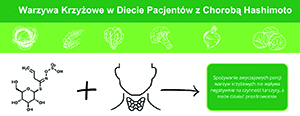Cruciferous vegetables In Hashimoto’s disease diet
DOI:
https://doi.org/10.18388/pb.2021_547Abstract
Thyroid is an endocrine gland that is responsible for producing and releasing two hormones: triiodothyronine (T3) and thyroxine (T4). Hypothyroidism as the disorder happens when the synthesis of those hormones is impaired. It is most commonly caused by the chronic autoimmune inflammation of the thyroid, referred to as Hashimoto’s disease. In this case, apart from the pharmacological treatment, diet does matter a great deal, too. It is extremely important to provide the body with all the essential nutrients. Exclusion of products that may interfere with the uptake of iodine - the trace element that is indispensable for the thyroid gland hormone synthesis, seems to be crucial, too. They most of all include cruciferous vegetables containing goitrogens (goitrogenic substances). This review aimed to collect and summarize the available scientific data on the safety of the cruciferous vegetable consumption within the context of its impact upon the thyroid function.
Published
Issue
Section
License
Copyright (c) 2024 Dominika P. Dobiecka, Justyna Moskwa, Renata Markiewicz-Żukowska, Katarzyna Socha, Sylwia K. Naliwajko

This work is licensed under a Creative Commons Attribution 4.0 International License.
All journal contents are distributed under the Creative Commons Attribution-ShareAlike 4.0 International (CC BY-SA 4.0) license. Everybody may use the content following terms: Attribution — You must give appropriate credit, provide a link to the license, and indicate if changes were made, ShareAlike — If you remix, transform, or build upon the material, you must distribute your contributions under the same license as the original. There are no additional restrictions — You may not apply legal terms or technological measures that legally restrict others from doing anything the license permits.
Copyright for all published papers © stays with the authors.
Copyright for the journal: © Polish Biochemical Society.



